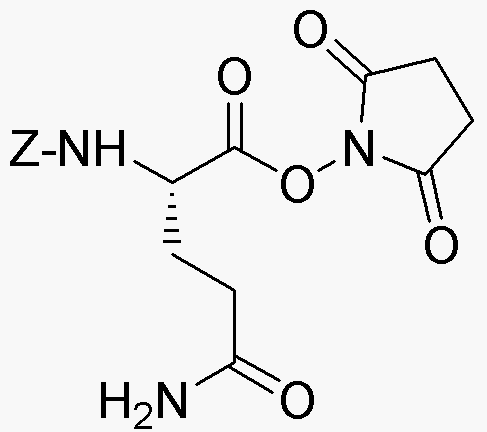Z-L-glutamine N-hydroxysuccinimide ester is widely utilized in research focused on:
- Bioconjugation: This compound serves as a versatile linker in bioconjugation processes, allowing researchers to attach biomolecules such as proteins or antibodies to surfaces or other molecules, enhancing the functionality of diagnostic and therapeutic agents.
- Drug Development: In pharmaceutical research, it is used to create prodrugs that improve the solubility and bioavailability of active pharmaceutical ingredients, leading to more effective treatments with potentially fewer side effects.
- Protein Labeling: The compound facilitates the labeling of proteins for tracking and imaging in biological studies, which is crucial for understanding protein interactions and cellular processes.
- Peptide Synthesis: It plays a significant role in peptide synthesis, allowing for the selective modification of amino acids, which is essential for developing novel peptides with specific biological activities.
- Diagnostics: In the field of diagnostics, it is utilized in the development of assays and sensors that detect specific biomolecules, improving the accuracy and sensitivity of medical tests.
General Information
Properties
Safety and Regulations
Applications
Z-L-glutamine N-hydroxysuccinimide ester is widely utilized in research focused on:
- Bioconjugation: This compound serves as a versatile linker in bioconjugation processes, allowing researchers to attach biomolecules such as proteins or antibodies to surfaces or other molecules, enhancing the functionality of diagnostic and therapeutic agents.
- Drug Development: In pharmaceutical research, it is used to create prodrugs that improve the solubility and bioavailability of active pharmaceutical ingredients, leading to more effective treatments with potentially fewer side effects.
- Protein Labeling: The compound facilitates the labeling of proteins for tracking and imaging in biological studies, which is crucial for understanding protein interactions and cellular processes.
- Peptide Synthesis: It plays a significant role in peptide synthesis, allowing for the selective modification of amino acids, which is essential for developing novel peptides with specific biological activities.
- Diagnostics: In the field of diagnostics, it is utilized in the development of assays and sensors that detect specific biomolecules, improving the accuracy and sensitivity of medical tests.
Documents
Safety Data Sheets (SDS)
The SDS provides comprehensive safety information on handling, storage, and disposal of the product.
Product Specification (PS)
The PS provides a comprehensive breakdown of the product’s properties, including chemical composition, physical state, purity, and storage requirements. It also details acceptable quality ranges and the product's intended applications.
Certificates of Analysis (COA)
Search for Certificates of Analysis (COA) by entering the products Lot Number. Lot and Batch Numbers can be found on a product’s label following the words ‘Lot’ or ‘Batch’.
Número de catálogo
Número de lote/lote
Certificates Of Origin (COO)
This COO confirms the country where the product was manufactured, and also details the materials and components used in it and whether it is derived from natural, synthetic, or other specific sources. This certificate may be required for customs, trade, and regulatory compliance.
Número de catálogo
Número de lote/lote
Safety Data Sheets (SDS)
The SDS provides comprehensive safety information on handling, storage, and disposal of the product.
DownloadProduct Specification (PS)
The PS provides a comprehensive breakdown of the product’s properties, including chemical composition, physical state, purity, and storage requirements. It also details acceptable quality ranges and the product's intended applications.
DownloadCertificates of Analysis (COA)
Search for Certificates of Analysis (COA) by entering the products Lot Number. Lot and Batch Numbers can be found on a product’s label following the words ‘Lot’ or ‘Batch’.
Número de catálogo
Número de lote/lote
Certificates Of Origin (COO)
This COO confirms the country where the product was manufactured, and also details the materials and components used in it and whether it is derived from natural, synthetic, or other specific sources. This certificate may be required for customs, trade, and regulatory compliance.


